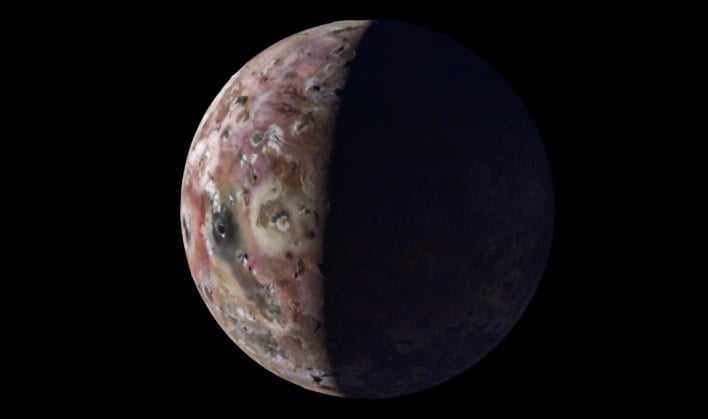NASA's Juno Captures Stunning Views Of A Hellish Volcanic Moon Of Jupiter

Juno’s principal investigator, Scott Bolton, announced the new findings during a recent news conference at the European Geophysical Union General Assembly in Vienna. The spacecraft made close flybys of Io in December of last year, and again in February of this year. It came within 930 miles of the volcanic surface of Jupiter’s most active moon, and obtained the first close-up images of its northern latitudes.
“Io is simply littered with volcanoes, and we caught a few of them in action,” remarked Bolton. “We also got some great close-ups and other data on a 200-kilometer-long (127-mile-long) lava lake called Loki Patera. There is amazing detail showing these crazy islands embedded in the middle of a potentially magma lake rimmed with hot lava.” Bolton added, “The specular reflection our instruments recorded of the lake suggests parts of Io’s surface are as smooth as glass, reminiscent of volcanically created obsidian glass on Earth.”
NASA’s spacecraft used its Microwave Radiometer (MWR) instrument to unveil the moon is relatively smoother than Jupiter’s other Galilean moons. The instrument was also able to determine that Io has poles which are colder than middle latitudes.

Juno has been monitoring Io from afar since the spacecraft arrived at Jupiter in 2016. It was not until its 57th and 58th orbit, however, that the spacecraft came within roughly 930 miles of Io’s surface. The passes in December and February allowed scientists to compare data and images from previous observations from Juno and other spacecraft.
The spacecraft’s JunoCam instrument captured the top image of Io during Juno’s 60th flyby of Jupiter on April 9, 2024. It was also the first-ever image captured of the moon’s south polar region. The image was created by citizen scientist Thomas Thomopoulos by applying further processing to an image created from raw JunoCam data by another citizen scientist, Gerald Eichstadt.
As Juno continues to orbit Jupiter, it will proceed with its primary mission goal of collecting data that could help scientists better understand Jupiter’s water abundance. While the spacecraft continues collecting more data, space explorers can enjoy all the spacecraft has revealed so far about Io, Jupiter, and the Jovian planet’s other moons.

